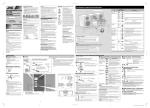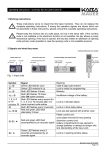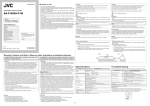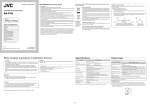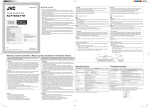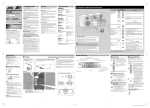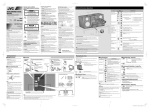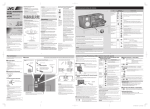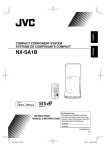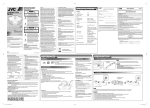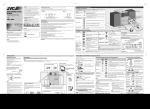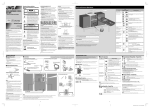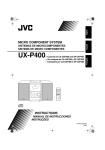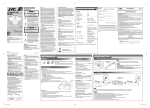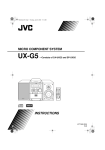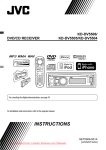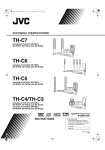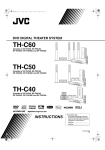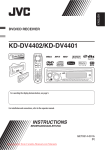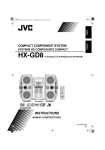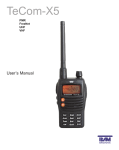Download JVC UX-LP55B User Guide Manual - DVDPlayer
Transcript
Thank you for purchasing a JVC product. INSTRUCTIONS LVT2263-002B[J] 0811KMMMDWCDT © 2011 Victor Company of Japan, Limited Le symbole de l’éclair à l’intérieur d’un triangle équilatéral est destiné à alerter l’utilisateur sur la présence d’une “tension dangereuse” non isolée dans le boîtier du produit. Cette tension est suffisante pour provoquer l’électrocution de personnes. Le point d’exclamation à l’intérieur d’un triangle équilatéral est destiné à alerter l’utilisateur sur la présence d’opérations d’entretien importantes au sujet desquelles des renseignements se trouvent dans le manuel d’instructions. For Canada/pour le Canada THIS DIGITAL APPARATUS DOES NOT EXCEED THE CLASS B LIMITS FOR RADIO NOISE EMISSIONS FROM DIGITAL APPARATUS AS SET OUT IN THE INTERFERENCE-CAUSING EQUIPMENT STANDARD ENTITLED “DIGITAL APPARATUS,” ICES-003 OF THE DEPARTMENT OF COMMUNICATIONS. CET APPAREIL NUMERIQUE RESPECTE LES LIMITES DE BRUITS RADIOELECTRIQUES APPLICABLES AUX APPAREILS NUMERIQUES DE CLASSE B PRESCRITES DANS LA NORME SUR LE MATERIEL BROUILLEUR; “APPAREILS NUMERIQUES”, NMB-003 EDICTEE PAR LE MINISTRE DES COMMUNICATIONS. For U.S.A. Caution: Changes or modifications not expressly approved by party responsible for compliance could void the user’s authority to operate the equipment. Note: This equipment has been tested and found to comply with the limits for a Class B digital device, pursuant to Part 15 of the FCC Rules. These limits are designed to provide reasonable protection against harmful interference in a residential installation. This equipment generates, uses and can radiate radio frequency energy and, if not installed and used in accordance with the instructions, may cause harmful interference to radio communications. However, there is no guarantee that interference will not occur in a particular installation. If this equipment does cause harmful interference to radio or television reception, which can be determined by turning the equipment off and on, the user is encouraged to try to correct the interference by one or more of the following measures: – Reorient or relocate the receiving antenna. – Increase the separation between the equipment and receiver. – Connect the equipment into an outlet on a circuit different from that to which the receiver is connected. – Consult the dealer or an experienced radio/TV technician for help. Pour les Etats-Unis Attention: Les changements ou les modifications qui ne sont pas explicitement approuvés par la partie responsable de l’observance pourraient mettre fin au droit de l’utilisateur d’utiliser le matériel. Remarque: Cet appareil a été testé et il s’est avéré conforme aux limites applicables à un appareil numérique de classe B, en vertu de la Partie 15 des Règles de la FCC. Ces limites sont conçues de manière à assurer une protection raisonnable contre les interférences nuisibles dans une installation résidentielle. Cet appareil produit, utilise et peut émettre une énergie de haute fréquence et, s’il n’est pas installé et utilisé en conformité avec les instructions, il peut causer des interférences nuisibles aux communications radio. Il n’y a, toutefois, aucune garantie que des interférences ne se produiront pas dans une installation particulière. Si cet appareil cause effectivement des interférences nuisibles à la réception de la radio ou de la télévision, ce qu’on peut établir en mettant l’appareil en marche et à l’arrêt, nous encourageons l’utilisateur à tenter de corriger l’interférence par une ou plusieurs des mesures suivantes : – réorienter ou déplacer l’antenne de réception ; – accroître la séparation entre l’appareil et le récepteur ; – brancher l’appareil dans une prise ou un circuit autre que celui auquel le récepteur est branché ; – consulter un vendeur ou un technicien radio/TV expérimenté pour obtenir de l’aide. CLASS II apparatus with double insulation, and no protective earth provided. Appareil de CLASSE II avec isolant double et sans protection de mise à la terre. WARNING: TO PREVENT FIRE OR SHOCK HAZARDS, DO NOT EXPOSE THIS APPARATUS TO RAIN OR MOISTURE. AVERTISSEMENT: POUR PRÉVENIR LES RISQUES D’INCENDIE OU DE CHOCS ÉLECTRIQUES, NE PAS EXPOSER CE APPAREIL À LA PLUIE OU À L’HUMIDITÉ. CAUTION To reduce the risk of electrical shocks, fire, etc.: 1. Do not remove screws, covers or cabinet. 2. Do not expose this appliance to rain or moisture. ATTENTION Afin d’éviter tout risque d’électrocution, d’incendie, etc.: 1. Ne pas enlever les vis ni les panneaux et ne pas ouvrir le coffret de l’appareil. 2. Ne pas exposer l’appareil à la pluie ni à l’humidité. CAUTION The button in any position does not disconnect the mains line. Disconnect the mains plug to shut the power off completely (the STANDBY lamp goes off). The MAINS plug or an appliance coupler is used as the disconnect device, the disconnect device shall remain readily operable. • When the system is on standby, the STANDBY lamp lights red. • When the system is turned on, the STANDBY lamp goes off. The power can be remote controlled. ATTENTION La touche , quelle que soit sa position, ne coupe pas la ligne principale. Débrancher la fiche principale pour couper complètement l’alimentation du secteur (le témoin STANDBY s’éteint). La fiche secteur ou un coupleur est utilisé comme dispositif de déconnexion de l’appareil, et l’appareil déconnecté doit être prêt à être utilisé. • Quand l’appareil est en mode d’attente, le témoin STANDBY est allumé en rouge. • Quand l’appareil est sous tension, le témoin STANDBY s’éteint. L’alimentation peut être commandée à distance. CAUTION: Excessive sound pressure from earphones or headphones can cause hearing loss. ATTENTION: Une pression acoustique excessive des écouteurs ou du casque d'écoute peut entraîner une perte auditive. USB • See “Listening to an iPod/Viewing Images on the iPod” on page 5. E S U U R T M F U A T D IN E G E P E A T R D A Y Press repeatedly to select “TUNER FM” or “AUDIO IN.” M E A U N O M D N A U S B R M O D E T DIO U N IN E E R R P R O G R A M iPod C U P M E T AUDIO IN E B L E D O W N V O L U S E E L C N A R /C TUNER S S /T U H B S P T Y B A M E N Side view/Côté A U T O S S S L T O E B U E Y B P D T U R B O Front view/Face VOLUME CAUTION: • Do not block the ventilation openings or holes. (If the ventilation openings or holes are blocked by a newspaper or cloth, etc., the heat may not be able to get out.) • Do not place any naked flame sources, such as lighted candles, on the apparatus. • When discarding batteries, environmental problems must be considered and local rules or laws governing the disposal of these batteries must be followed strictly. • Do not expose this apparatus to rain, moisture, dripping or splashing and that no objects filled with liquids, such as vases, shall be placed on the apparatus. ATTENTION: • Ne bloquez pas les orifices ou les trous de ventilation. (Si les orifices ou les trous de ventilation sont bloqués par un journal un tissu, etc., la chaleur peut ne pas être évacuée correctement de l’appareil.) • Ne placez aucune source de flamme nue, telle qu’une bougie, sur l’appareil. • Lors de la mise au rebut des piles, veuillez prendre en considération les problèmes de l’environnement et suivre strictement les règles et les lois locales sur la mise au rebut des piles. • N’exposez pas cet appareil à la pluie, à l’humidité, à un éqgouttement ou à des éclaboussures et ne placez pas des objets remplis de liquide, tels qu’un vase, sur l’appareil. CAUTION: Battery shall not be exposed to excessive heat such as sunshine, fire or the like. ATTENTION: Les piles ne doivent en aucun cas être exposées à une chaleur excessive (lumière du solei, feu, etc.). Drop the volume in a moment Emphasize the sound (Sound Turbo)* Reinforce the bass sound (Hyper Bass Sound)* Adjust the tone (Bass/Treble) PHONES jack Stereo mini plug cord Using Headphones • Be sure to turn down the volume before connecting or putting on the headphones. – Connecting the headphones will deactivate the speakers. – Sound adjustments also affect the sound through the headphones. • While playing back iPod/iPhone, no sound is heard from the headphones connected to the System. [European Union only] [Union européenne seulement] HBS The BASS indicator lights up. To cancel this function, press again. — BASS/TREBLE Press once for adjusting the bass level; twice for treble level, then, press VOLUME +/–. Adjustable range: –3 to +3. VOLUME Dim the display DIMMER You can dim the display window and illumination lamp. While the System is turned on... NOTE: • DO NOT turn off (standby) the System with the volume set to an extremely high level; otherwise, the sudden blast of sound can damage your hearing, speakers and headphones when you turn on the System or start playback. • Select a place which is level, dry and neither too hot nor too cold—between 5˚C and 35˚C. Do not connect the AC power cord until all other connections have been made. To connect the monitor (not supplied) Video cord (not supplied) To connect the FM antenna (supplied) Extend it so that you can obtain the best reception. FM antenna (supplied) Outdoor FM antenna (not supplied) For better FM reception • Make sure the antenna conductors do not touch any other terminals, connecting cords and power cord. Also, keep the antennas away from metallic parts of the System, connecting cords, and the AC power cord. This could cause poor reception. • Make sure both the speakers are connected correctly and firmly. • When connecting the speaker cords, match the polarity of the speaker terminals: red color to (+) and black color to (–). • DO NOT connect more than one speaker to each terminal. • DO NOT allow the conductor of the speaker cords to be in touch with the metallic parts of the System. This System can play back... – CD. – CD-R/CD-RW recorded in audio CD format (CD-DA) or recorded MP3/WMA files in ISO 9660 format. – USB mass storage class device containing MP3/WMA files. • When playing back an MP3 or WMA track, MP3 or WMA indicator lights up. Loading a Disc (on the System only) Press to open the disc tray. 1 2 • When using an 8 cm (3 3/16 inch) disc, place it on the inner circle of the disc tray. Set the clock and timer — CLOCK/ TIMER Change the display information — — — DISPLAY PTY Basic Disc/USB Mass Storage Class Device Operations To Play back the disc Press CD Play back the USB mass storage class device Stop playback For setting the clock, see “Setting the Clock and Using Timers” on page 6. The display information changes as follows: FM: Frequency = Clock CD: Current track elapsed time = Clock MP3/WMA: Current track elapsed time = ID3 tag = Current group/track = Clock This button is not used for the System. Select a track Rear view Press to close the disc tray. UP DOWN Connecting a USB Mass Storage Class Device Forward search/ Reverse search You can connect a USB mass storage class device such as a USB flash memory device, MP3 player, multimedia card reader, etc. to the System. To connect the speaker cords Lithium coin battery (product number: CR2025) Front view USB cable (not supplied) NOTES: Press and hold • Store the battery in a place where children cannot reach. If a child accidentally swallows the battery, consult a doctor immediately. • To prevent the battery from overheating, cracking, or starting a fire: – Do not recharge, short, disassemble or heat the battery or dispose of it in a fire. – Do not leave the battery with other metallic materials. – Wrap the battery with tape and insulate when throwing away or saving it. – Do not poke the battery with tweezers or similar tools. • Dispose of battery in the proper manner, according to federal, state, and local regulations. USB memory (not supplied) Or NOTES: Release • When connecting with a USB cable, use the USB 2.0 cable whose length is less than 1 m. • USB mass storage class device is charged through the USB MEMORY terminal when the System is turned on. (Some USB mass storage class device may be charged through the USB terminal only when “USB” is selected as the source.) • You cannot connect a computer to the USB MEMORY terminal of the System. • Do not disconnect the USB mass storage class device when the System is turned on. It may cause malfunction of both this System and the device. • Noise and static electricity may stop the USB mass storage class device sound. In this case, disconnect and connect the USB mass storage class device again after turning off the System. Insert Red To a wall outlet Plug the AC power cord only after all connections are complete. Prohibiting Disc Ejection From right speaker CAUTION: Danger of explosion if battery is incorrectly replaced. Replace only with the same or equivalent type. Black From left speaker (on the System only) You can lock the disc tray so that no one can eject the loaded disc. 1 2 3 While no USB device is connected, select “USB” as the source. Press briefly. Press and hold for more than 2 seconds. To cancel the prohibition, repeat the same procedure. 2 1 • While playback is stopped, total track number and total playing time (for MP3/WMA files, group number and track number) appear. Select the next tracks. 2 To go back to the beginning of the current or previous tracks. Select a group (MP3/WMA only) Change display information Playing Repeatedly—Repeat Play Indication/Result • Current track number and elapsed playing time appear. • During playback, press again to pause. Press repeatedly to specify the repeat mode as follows: : Repeats the current (or specified) track. : Repeats all tracks in the current group (MP3/WMA only). ALL: Repeats all tracks. No indicator (Off): Normal playback REPEAT USB Disconnect the supplied FM antenna, and connect to an outdoor FM antenna using a 75 Ω wire with coaxial type connector. 3 Downloaded From DvDPlayer-Manual.com JVC Manuals The S.TURBO indicator lights up. To cancel this function, press again. * Sound Turbo and Hyper Bass Sound cannot be used at the same time. NOTES: Monitor For USA-California Only This product contains a CR Coin Cell Lithium Battery which contains Perchlorate Material – special handling may apply. See www.dtsc.ca.gov/hazardouswaste/perchlorate SOUND TURBO 3 Connections When you use the remote control for the first time, pull out the insulation sheet. To Replace the Battery in the Remote Control — To restore the volume, press again, or adjust the volume level. Playing Back a Disc/USB Mass Storage Class Device Prepare the Remote Control Insulation sheet FADE MUTING — — • The operations on pages 4 to 6 are explained using the remote control, unless mentioned otherwise. However, if the System has the same or similar button names, they can also be used for the operations. • In this manual, “iPod” means iPod, iPod touch and iPhone device. When iPod touch or iPhone device is especially referred to, “iPod touch” or “iPhone” is used. Getting Started Supplied Accessories • For “TUNER FM,” see “Listening to FM Broadcasts” on page 5. • For “AUDIO IN,” see “Listening to Other Equipment” on page 5. Adjustable range: Level 0 (“VOL MIN”) to level 40 (“VOL MAX”). Adjust the volume 1 After unpacking, check to be sure that you have all the following items. • Remote control, RM-SUXLP6R (× 1) • Lithium coin battery CR2025 (× 1) – The battery has been installed in the remote control when shipped from the factory. • FM antenna (× 1) • Protection sheet (× 1) If anything is missing, consult your dealer immediately. • See “Playing Back a Disc/USB Mass Storage Class Device” on page 4. CD C T LO IM C E K R / ENGLISH Indication/Result The STANDBY lamp on the System turns off/on. Select a source R The lightning flash with arrowhead symbol, within an equilateral triangle is intended to alert the user to the presence of uninsulated “dangerous voltage” within the products enclosure that may be of sufficient magnitude to constitute a risk of electric shock to persons. The exclamation point within an equilateral triangle is intended to alert the user to the presence of important operating and maintenance (servicing) instructions in the literature accompanying the appliance. —Consists of CA-UXLP55W and SP-UXLP55W Press System Remote Turn on or off (standby) the power STANDBY lamp iP o d UX-LP55W To Point at the remote sensor on the front panel. IS P L —Consists of CA-UXLP55B and SP-UXLP55B Basic and Common Operations D UX-LP55B CAUTION: Proper Ventilation To avoid risk of electric shock and fire, and to prevent damage, locate the apparatus as follows: 1. Front: No obstructions and open spacing. 2. Sides/Top/Back: No obstructions should be placed in the areas indicated by the dimensions in the illustration. 3. Bottom: Place on the level surface. Maintain an adequate air path for ventilation by placing on a stand with a height of 10 cm or more. ATTENTION: Aération correcte Pour prévenir tout risque de décharge électrique ou d'incendie et éviter toute détérioration, installez l'appareil de la manière suivante: 1. Avant: Bien dégagé de tout objet. 2. Flancs/ Dessus/ Arrière: Aucun obstacle ne doit être placé dans les zones indiquées par les dimensions dans l’illustration. 3. Dessous: Posez l’appareil sur une surface plane et horizontale. Veillez à ce que sa ventilation correcte puisse se faire en le plaçant sur un support d’au moins dix centimètres de hauter. IM M E MICRO COMPONENT SYSTEM IMPORTANT FOR LASER PRODUCTS 1. CLASS 1 LASER PRODUCT 2. CAUTION: Do not open the top cover or cabinet. There are no user serviceable parts inside the unit; leave all servicing to qualified service personnel. 3. CAUTION: (For U.S.A.) Visible and/or invisible class II laser radiation when open. Do not stare into beam. (For Canada) Visible and/or invisible class 1M laser radiation when open. Do not view directly with optical instruments. 4. CAUTION: Use of any controls, adjustments, or procedures other than those specified herein may result in hazardous radiation exposure. 5. REPRODUCTION OF LABEL: CAUTION LABEL, PLACED INSIDE THE UNIT. IMPORTANT POUR PRODUITS LASER 1. PRODUIT LASER CLASSE 1 2. ATTENTION: N’ouvrez pas le couvercle supérieur ni le coffret de l’appareil. Il n’y a aucune pièce réparable par l’utilisateur à l’intérieur de l’appareil; confiez toute réparation à un personnel qualifié. 3. ATTENTION: (Pour les Etats-Unis) Radiation laser de classe II visibles et/ou invisible si l’appareil est ouvert. Ne regardez pas le rayon. (Pour le Canada) Rayonnement laser visible et/ou invisible de classe 1M une fois ouvert. Ne pas regarder directement avec des instruments optiques. 4. ATTENTION: Toute utilisation des commandes, réglages ou procédures autres que celles spécifiées dans ce document risque d’entraîner une exposition dangereuse aux rayonnements. 5. REPRODUCTION DE L’ÉTIQUETTE: ÉTIQUETTE DE PRÉCAUTION PLACÉE À L’INTERIEUR DE L’APPAREIL. D Warnings, Cautions and Others / Mises en garde, précautions et indications diverses DISPLAY CD or USB Programming the Playing Order—Program Play 1 2 Select the next groups. PROGRAM During stops, press so that the PRGM (program) indicator lights up. Select a track number. or Select the previous groups. Press and hold to fast-forward the track during playback. To stop searching, release the button. Press and hold to fast-forward the track during playback. To stop searching, press 6. Press and hold to fast-reverse the track during playback. To stop searching, release the button. Press and hold to fast-reverse the track during playback. To stop searching, press 6. Press repeatedly. 3 4 5 SET Press to program the selected track. Repeat steps 2 and 3 to program other tracks you want. • If you try to program a 33rd track, “PRG FULL” will appear. The tracks are played back in the programmed order. or USB CD Operations for Program Play (while program stop mode) • To check the programmed contents, press SET repeatedly. • To add tracks, after “- - -” appears on the display by pressing SET repeatedly, repeat steps 2 and 3 above. • To erase or exit the program, press 7. – The stored program is not kept. Playing at Random—Random Play NOTES: • If no disc is inserted or no USB mass storage class device is connected, “NO DISC” or “NO USB” appears on the main display. • If MP3/WMA files are not recorded on the disc or in the USB mass storage class device, “NO PLAY” or “NO DATA” appears on the main display. RESUME Play Press RESUME to activate RESUME Play so that the RESUME indicator lights up. When you stop the playback by one of the following operations, this System stores the beginning of the stopped track on the disc or USB mass storage class device. – Pressing 7 once – Changing the source When you start playback again, playback starts from the beginning of the stopped track. To clear the memory, press 7 while playback is stopped, open the disc tray or disconnect the USB mass storage class device. • When you clear the memory and start playback, playback starts from the first track To deactivate RESUME Play, press RESUME again. NOTE: This function does not work in Program Play. 4 1 RANDOM Press so that the RND (random) indicator lights up and playback starts in random order. Operations for Random Play • To skip a track, press ¢. • To go back to the beginning of the current track, press 4. • To exit from random play, press RANDOM so that the RND (random) indicator disappears during playback. Listening to an iPod/Viewing Images on the iPod Connecting an iPod Listening to FM Broadcasts Basic Tuner Operations Basic iPod Operations Push PUSH-OPEN to open the direct dock for iPod. Front view Insert the iPod directly to the connector pins. To Play back an iPod Apple iPod (separately purchased) Press iPod Dock adapter (supplied with the iPod or sold separately) Select a track Press to select the next tracks during playback. Forward search/ Reverse search Press to go back to the beginning of the current or previous tracks during playback. Press and hold to fast-forward the track during playback. Press and hold to fast-reverse the track during playback. Connector pins To detach the dock adapter from the dock: Pull up the dock adapter with your fingernail or sharp pointed tool using the slot. • Be careful not to injure your fingertips or damage the terminal of the dock. Display the menu/Go back to the previous menu Select an item on the menu When the iPod touches the unit, attach the protection sheet (supplied) to the panel of the unit. • Use the Dock adapter (supplied with your iPod or to be purchased) when connecting an iPod. • When you close the direct dock, remove the dock adapter. • Be sure to reduce the volume on the System to the minimum level before connecting an iPod. Adjust the volume after starting playback. • DO NOT connect or disconnect the iPod when the System is turned on. • You cannot send any data to your iPod from the System. • Do not carry the System with the iPod connected. You might drop it or it might cause damages to the iPod dock. • Do not touch or hit the iPod terminal pins or connector pins in the iPod dock directly. It might cause damages to the connector part. • Before viewing a video/picture from your iPod on your monitor, make the appropriate video setting on the iPod. For details of the setting, see the instruction manual for iPod. Indication/Result The System detects the iPod and starts playback. • During playback, press again to pause. • To turn off the iPod, press and hold. or SET RANDOM REPEAT • The UP/DOWN buttons work in the same way as operating the click wheel of iPod counterclockwise/clockwise. (Refer to the instruction manual for the iPod for details.) • Refer to the instruction manual for the iPod for details. • Refer to the instruction manual for the iPod for details. Press repeatedly. DISPLAY Setting the video output of the iPod Before playing a video, select the appropriate video output to view a video/picture on the monitor or the iPod. Press and hold for more than 2 seconds to switch the video output when the System is turned on. (“VOUT ON” is selected when shipped from the factory.) • VOUT ON: Displays video/picture on the connected monitor. • VOUT OFF: Displays video/picture on the iPod. AUDIO IN TUNER or Tune in to a preset station UP or Indication/Result Press repeatedly until FM band is selected. Press and hold for more than 2 seconds. The System starts searching for stations and stops when a station of sufficient signal strength is tuned in. • If an FM program is broadcast in stereo, the ß (stereo) indicator lights up (only when the reception is good). • Press during searching to stop. • Press repeatedly to change the frequency step by step. Press to select its preset number. • For presetting stations, see below. DOWN — UP Press Select a frequency MENU/CANCEL DOWN Play back at random Play back repeatedly Change display information To Select FM band Change the FM reception mode (When an FM stereo broadcast is hard to receive) TUNER MODE Press to improve reception. The ˜ (mono) indicator lights up. Stereo effect will be lost. To restore the stereo effect, press again. Presetting Stations Maintenance Listening to Other Equipment To get the best performance of the System, keep your discs and mechanism clean. Front view Digital Audio Player, etc. Stereo mini plug cord (not supplied) 1 2 3 4 To audio output (or headphone out, etc.) Turn the volume to minimum. VOLUME AUDIO IN Press repeatedly to select “AUDIO IN.” TUNER Start playing the connected equipment. Adjust the volume. To Adjust the Audio Input Level If the sound from the other equipment connected to the AUDIO IN jack is too loud or too quiet, you can change the audio input level through the AUDIO IN jack (without changing the volume level). Press and hold for more than 2 seconds while “AUDIO IN” is selected as the source. You can select one of three levels as follows: SET You can preset 30 FM stations manually. 1 2 Tune in to a station you want to preset. PROGRAM 3 UP or As the number increases, the sound becomes louder. Press to activate the preset number entry mode. • Finish the following steps while the indication on the display is flashing. Press to select a preset number for the station you want to store. SET To clean the disc: • Wipe the disc with a soft cloth in a straight line from center to edge. Cleaning the System • Stains should be wiped off with a soft cloth. If the System is heavily stained, wipe it with a cloth soaked in water-diluted neutral detergent and wrung well, then wipe clean with a dry cloth. • Since the System may deteriorate in quality, become damaged or get its paint peeled off, be careful about the following: – DO NOT wipe it hard. – DO NOT wipe it with thinner or benzine. – DO NOT apply any volatile substance such as insecticides to it. – DO NOT allow any rubber or plastic to remain in contact for a long time. JVC bears no responsibility for any loss of data in USB mass storage class device or iPod while using this System. Microsoft and Windows Media are either registered trademarks or trademarks of Microsoft Corporation in the United States and/or other countries. • “Made for iPod” and “Made for iPhone” mean that an electronic accessory has been designed to connect specifically to iPod or iPhone, respectively, and has been certified by the developer to meet Apple performance standards. Apple is not responsible for the operation of this device or its compliance with safety and regulatory standards. Please note that the use of this accessory with iPod or iPhone may affect wireless performance. • iPhone, iPod, iPod classic, iPod nano, and iPod touch are trademarks of Apple Inc., registered in the U.S. and other countries. DOWN 4 Handling discs • Remove the disc from its case by holding it at the edge while pressing the center hole lightly. • Do not touch the shiny surface of the disc, or bend the disc. • Put the disc back in its case after use. • Be careful not to scratch the surface of the disc when placing it back in its case. • Avoid exposure to direct sunlight, temperature extremes, and moisture. Press to store the station. Learning More about This System Basic and Common Operations (see page 3) • Pressing one of the source buttons also turns on the System and starts playing back if the source is ready or connected. Listening to an iPod/Viewing Images on the iPod (see page 5) • Compatible iPod models: Made for iPod touch (4th generation) iPod touch (3rd generation) iPod touch (2nd generation) iPod touch iPod classic iPod nano (6th generation) iPod nano (5th generation) iPod nano (4th generation) iPod nano (3rd generation) iPod nano (2nd generation) iPhone 4 iPhone 3GS iPhone 3G Playing Back a Disc/USB Mass Storage Class Device (see page 4) • This System cannot play “packet write” discs. • For MP3/WMA playback... – In this manual, “file” and “track” are interchangeably used for MP3/WMA operations. – This System can show the Tag data (Version 1). – MP3/WMA discs are required a longer readout time than regular CDs. (It depends on the complexity of the group/ file configuration.) – Some MP3/WMA files cannot be played back and will be skipped. This result from their recording processes and conditions. – When making MP3/WMA discs, use ISO 9660 Level 1 or Level 2 for the disc format. – This System can play back MP3/WMA files with the extension code <.mp3> or <.wma> (regardless of the letter case—upper/lower). – It is recommended that you make each MP3/WMA file at a sampling rate of 44.1 kHz and at bit rate of 128 kbps. This System cannot play back files made at bit rate of less than 64 kbps. – Playback order of MP3/WMA tracks may be different from the one you have intended while recording. If a folder does not include MP3/WMA tracks, they are ignored. • Do not use the following USB devices... – Whose rating is other than 5 V and exceeds 500 mA. – Equipped with special functions such as data security functions. – Divided by 2 or more partitions. • For the USB mass storage class device playback... – When connecting a USB mass storage class device, also refer to its manual. – Connect one USB mass storage class device to the System at a time. Do not use a USB hub. – This System is compatible with USB 2.0 Full Speed. – You can play back MP3/WMA files in a USB mass storage class device (maximum data transfer rate: 2 Mbps). – You cannot play back a file larger than 2 Gigabyte. – This System may not play back some USB mass storage class devices and does not support DRM (Digital Rights Management). • This System can recognize up to 255 groups in a disc. The total number of groups and tracks (in a disc) that can be recognized by the System is 512 (for MP3/WMA). • This System can recognize up to 99 groups and 999 tracks (with a maximum number of 255 tracks in a group) in a USB mass storage class device. Audio Video * Setting the Clock and Using Timers (see page 6) • You can set the clock and Daily Timer while the System is turned on. While setting the clock or Daily Timer, the display is turning on. • The clock may gain or lose 1 to 2 minutes per month. If this happens, readjust the clock. • When you unplug the AC power cord or if a power failure occurs, the clock and the timer will be canceled. You need to set the clock first, then the timer again. Timer Priority: • If you activate the Sleep Timer after Daily Timer starts playing the selected source, Daily Timer is canceled. – * Only for still picture • Sound distortion may occur when playing back audio sources with high recording levels. When distortion occurs, it is recommended to turn off the equalizer of the iPod. For information on operating the iPod, see the iPod instruction manual. Display Information RESUME indicator (See page 4.) S.TURBO (Sound Turbo) indicator (See page 3.) BASS indicator (See page 3.) File type indicators (See page 4.) Play mode indicators (See page 4.) Tuner indicator FM reception indicators (See page 5.) Timer mode indicators (See page 6.) SLEEP indicator (See page 6.) Main display Source indicators 5 Setting the Clock and Using Timers Setting the Clock 1 Using Daily Timer, you can wake up with your favorite music. • You can store three Daily Timer settings. • Tune into a station, place a CD, or connect a USB mass storage class device/iPod to the System beforehand. 1 CLOCK/ TIMER SET SET 2 UP Adjust the hour, then the minute. 2 UP or or DOWN DOWN SET SET • To go back to the previous step, press MENU/CANCEL. Setting the Sleep Timer Press repeatedly to specify the time (in minutes) as follows: AUTO STBY SLEEP 10 20 30 60 90 120 OFF 180 150 3 The SLEEP indicator lights up. • To check the remaining time until the System shuts off, press once. Turning Off the System Automatically —AUTO STANDBY (only for CD/USB) AUTO STBY SLEEP Press and hold until the A.STBY indicator lights on the display. • The A.STBY indicator starts flashing after playback stops. If no operation is done for about 3 minutes, the System turns off. Press CLOCK/TIMER repeatedly to display the desired Daily Timer number ( 1/ 2/ 3 lights up), then press SET during DAILY 1, DAILY 2 or DAILY 3 is displayed. 1 Adjust the hour then the minute for on-time. 2 Adjust the hour then the minute for off-time. 3 Select the playback source—“CD,” “USB,” “TUNER FM,” or “IPOD.” 4 Select the volume. • You can select the volume level –“VOLUME 0” (VOL MIN) to “VOLUME 40” (VOL MAX). If you select “VOLUME – –,” the volume is set to the last level when the System is turned off. Turn off the System. • When the on-time comes, the System sets the volume gradually to the preset level. • While Daily Timer is activated, indicator lights on the display. • To exit from the timer setting, press MENU/CANCEL as required. • To correct a misentry during the process, press MENU/ CANCEL. You can return to the previous step. To Turn Off the Daily Timer 1 Press repeatedly to select “DAILY 1,” “DAILY 2,” or “DAILY 3.” CLOCK/ TIMER 2 To cancel this function, press and hold again. Downloaded From DvDPlayer-Manual.com JVC Manuals CANCEL Specifications Troubleshooting Setting the Daily Timer Without setting the built-in clock, you cannot use Daily Timer and Sleep Timer. • “AM12:00” flashes on the main display until you set the clock. CLOCK/ Press and hold to activate the clock TIMER setting mode. 7 If you are having a problem with your System, check this list for a possible solution before calling for service. General Power does not come on. \ Power plug is not inserted securely. Plug in securely. Adjustments or settings are suddenly canceled before you finish. \ There is a time limit. Repeat the procedure again. Operations are disabled. \ The built-in microprocessor may malfunction due to external electrical interference. Unplug the AC power cord and then plug it back in. Unable to operate the System from the remote control. \ The path between the remote control and the remote sensor on the System is blocked. \ The batteries are exhausted. No sound is heard. \ Speaker connections are incorrect or loose. \ Headphones are connected. Disc/USB Mass Storage Class Device Operations The disc/USB mass storage class device does not play. \ The disc is placed upside down. Place the disc with the label side up. \ The disc is recorded with the “packet writing (UDF file system).” It cannot be played. Check the files you want to play back. \ The USB mass storage class device is not connected properly. MP3/WMA groups and tracks are not played back as you expect. \ Playing order is determined when the groups and tracks were recorded. It depends on the writing application. The disc/USB mass storage class device sound is discontinuous. \ The disc is scratched or dirty. \ MP3/WMA files have not been properly copied into the USB mass storage class device. Sounds from USB mass storage class device are interrupted. \ Noise and static electricity may stop the sound. In this case, disconnect and connect the USB mass storage class device again after turning off the System. The disc tray does not open or close. \ The AC power cord is not plugged in. \ Disc ejection is prohibited (see page 4). 6 iPod Operations Amplifier section The iPod does not play, but “CONNECT” appears on the display. \ The iPod battery is low or exhausted. Charge the iPod battery. OUTPUT POWER: 35 W per channel, min. RMS, driven into 4 Ω at 1 kHz with no more than 10% total harmonic distortion Speaker Impedance: 6 Ω – 16 Ω Audio input: AUDIO IN: STEREO MINI x 1 Digital input: USB MEMORY Radio Operations Hard to listen to broadcasts because of noise. \ Antenna connections are incorrect or loose. \ The FM antenna is not properly extended and positioned. \ Electrostatic discharge from your body may cause noise. If this happens, turn off and on the System again. Timer Operations Daily Timer does not work. \ The System has been turned on when the on-time comes. Timer starts working only when the System is turned off. USA ONLY Tuner section FM tuning range: 87.5 MHz - 108.0 MHz CD player section Dynamic range: Signal-to-noise ratio: Wow and flutter: 88 dB 85 dB Immeasurable iPod section iPod output power: VIDEO OUT: DC 5 V 1A Composite USB storage USB specification: Compatible device: Compatible file system: Bus power supply: Compatible with USB 2.0 Full Speed Mass storage class FAT16, FAT32 DC 5 V 500 mA General Power requirements: Power consumption: Dimensions (approx.): Mass (approx.): AC 120 V , 60 Hz 35 W (power on) Approx. 8 W (Daily Timer mode) 0.50 W or less (standby mode) 165 mm x 259 mm x 258 mm (6-1/2 inches x 10-1/4 inches x 103/16 inches) (W x H x D) 2.0 kg (4.4 lbs) BT-51018-6 (1008) Speakers Speaker units: Impedance: Dimensions (approx.): Mass (approx.): 10 cm (3-15/16 inches) x 1; 1.5 cm (5/8 inch) x 1 6Ω 140 mm x 250 mm x 188 mm (5-9/16 inches x 9-7/8 inches x 77/16 inches) (W x H x D) 1.4 kg (3.1 lbs) each Specifications and appearance are subject to change without prior notice. 8 A.STBY (Auto Standby) indicator (See page 6.)


